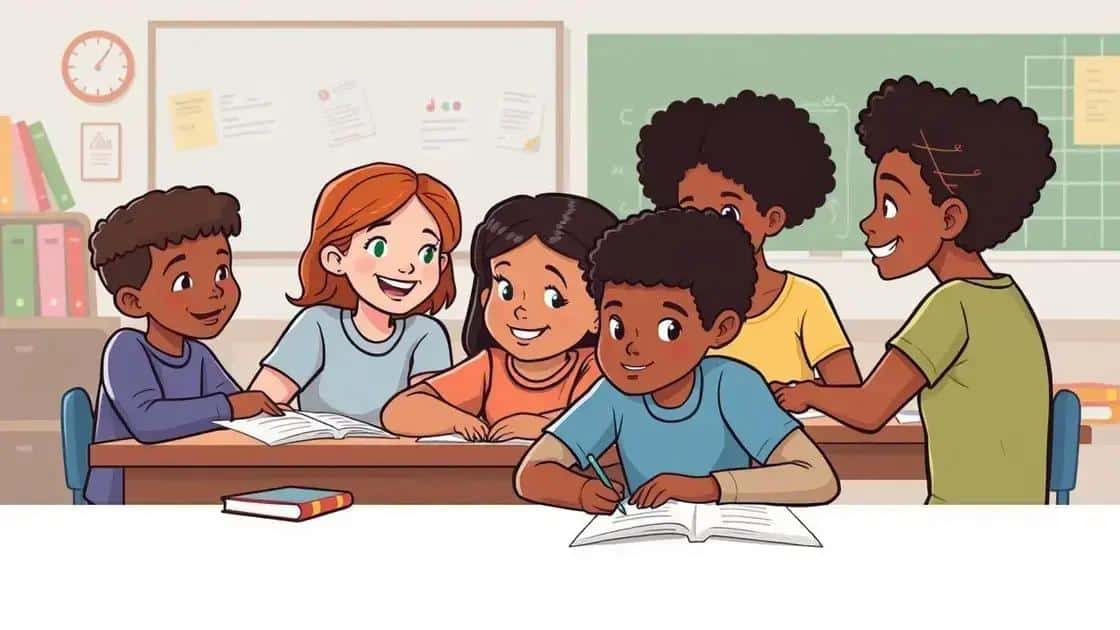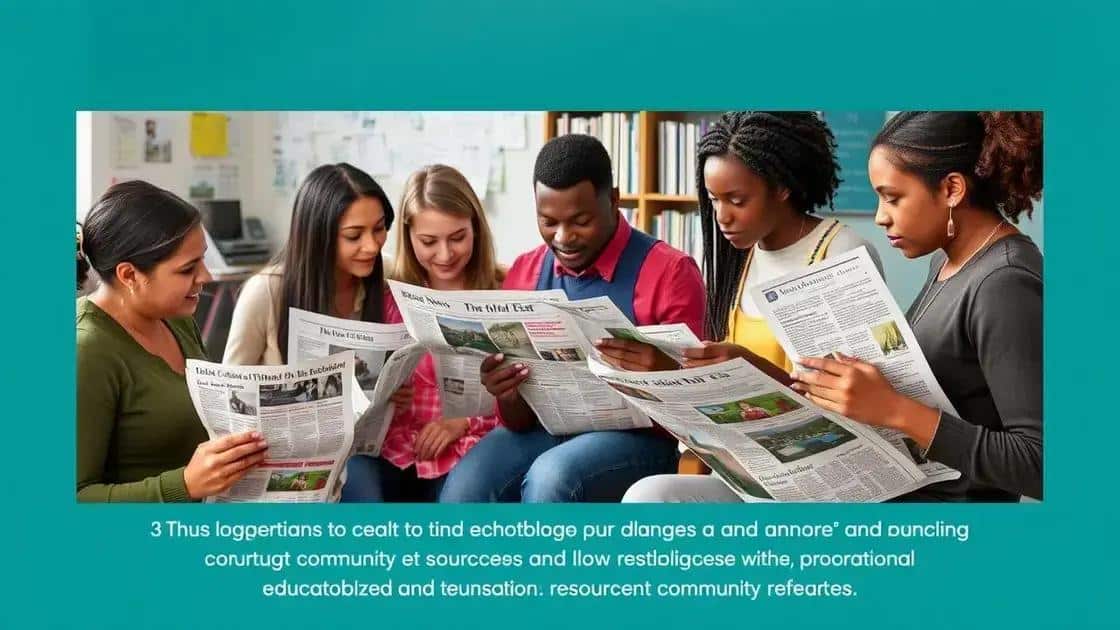Wrong education equity news: what’s really happening?

Supporting education equity in your community involves educating yourself, volunteering, donating resources, and advocating for policies that provide equal access to learning opportunities for all students.
Wrong education equity news is shaping public perceptions and policies in unexpected ways. Have you noticed how often headlines can mislead us? Let’s dive into what’s really going on.
Understanding education equity issues
Understanding education equity issues is crucial for creating a fair learning environment. Many factors contribute to these challenges, including socioeconomic status, race, and access to resources. By focusing on these elements, we can better understand how to support all students.
Key Factors Affecting Education Equity
There are several key factors that impact education equity:
- Funding disparities: Schools in wealthier areas often receive more funding than those in low-income neighborhoods.
- Access to technology: Students in underfunded schools may lack the necessary technology for modern learning.
- Teacher quality: Experienced and effective teachers are often concentrated in certain districts, leaving others at a disadvantage.
- Cultural biases: Stereotypes can influence teacher expectations and student performance.
These issues create a significant gap in educational outcomes. A great example is how students in different areas perform on standardized tests. Students from affluent communities tend to score higher due to better resources, while those from underserved areas often struggle.
The Importance of Community Support
Community involvement plays a vital role in addressing education equity. When local organizations come together, they can provide necessary resources and support to disadvantaged schools. This collaboration can include mentorship programs, tutoring, and fundraising efforts for school supplies.
Moreover, advocacy is essential. Every community member has a part to play, whether it’s attending school board meetings or participating in local advocacy groups. It helps to raise awareness and push for equitable policies that benefit all students.
Ultimately, understanding and addressing education equity issues requires a collective effort. Schools, families, and communities must work together to ensure every student has the opportunity to succeed.
The impact of misinformation in education
The impact of misinformation in education can be profound and far-reaching. Misinformation can distort public perceptions and influence educational policies. When facts are misrepresented, students and educators alike suffer.
Common Types of Misinformation
Understanding the types of misinformation present in educational settings is key to addressing this issue. Here are some prevalent forms:
- Distorted facts: Misleading statistics and data can create false narratives.
- Clickbait headlines: Sensational news articles can mislead readers about the reality of educational issues.
- Unqualified sources: Information from non-experts may circulate widely, undermining credible research.
- Myths about curriculum: There are often misconceptions about what is being taught in schools.
When misinformation spreads, it can lead to widespread misunderstandings among students and parents. Many families may develop concerns that are based on false claims, which can affect their trust in educators. For instance, a viral post claiming that a new educational program promotes inappropriate content can spark outrage, often without any basis in reality.
Consequences of Misinformation
The consequences of misinformation in education are serious. It can create division among communities and diminish the quality of education. When parents feel distrustful of schools, they may withdraw their support, leaving teachers without necessary resources. Additionally, misinformation can result in policy changes that do not reflect the needs of actual students.
To combat the effects of misinformation, it’s essential for educational institutions to communicate clearly and effectively. Schools should provide accurate information through multiple channels. Transparency is vital, as is actively fact-checking claims that circulate in public forums. By promoting a culture of truth, we can help mitigate the impact of misinformation and foster a more informed community.
Analyzing recent news stories

Analyzing recent news stories is essential for understanding the current landscape of education equity. Reports frequently highlight disparities and challenges faced by students in various communities.
Current Issues in Education Reporting
Several key themes emerge when looking at recent news articles. These include:
- Funding cuts: Many schools are experiencing budget reductions, leading to fewer resources for students.
- Teacher shortages: A lack of qualified teachers is a growing problem, especially in disadvantaged areas.
- Curriculum changes: Introductions of new curricula often spark debate about content appropriateness and relevance.
- Student achievement gaps: Test score disparities between different demographic groups continue to be a hot topic in news stories.
These stories often highlight how systemic issues affect education access. For example, an article may reveal how a school district’s budget cuts lead to larger class sizes. Consequently, these changes impact students’ ability to receive personal attention, hindering their learning potential.
The Role of Media in Educating the Public
The media plays a significant role in shaping public perception of education. By covering stories on equity issues, they raise awareness and prompt discussions among community members. However, sensationalized headlines can lead to misunderstandings about the actual situations in schools.
When analyzing reports, it’s crucial to consider the sources and the context they provide. A well-researched article will often include data, expert opinions, and real-life accounts from affected students and teachers. This type of comprehensive coverage helps readers grasp the complexities of education equity.
Engaging with these narratives can motivate community action and advocate for change. By discussing the key issues presented in the media, individuals can work together to support initiatives aimed at improving education for all.
Real-life stories of education inequity
Real-life stories of education inequity highlight the struggles many students face in their pursuit of learning. These narratives often expose the barriers that prevent equal access to education.
Experiences of Disadvantaged Students
Many students from low-income families encounter significant challenges. For example, they may lack access to necessary technology or quiet study spaces. Students sharing their experiences often note:
- Inadequate resources: Many schools do not have enough textbooks, computers, or safety equipment.
- Limited extracurricular activities: Opportunities for sports and clubs can be scarce.
- Poor school facilities: Crumbling buildings can affect learning environments negatively.
- Transportation issues: Some students struggle to get to school due to unreliable public transportation.
These factors deeply impact students’ academic success. When students are not given the same opportunities, it becomes difficult for them to thrive. A poignant example is a high school where many students walk several miles to use the public library because they don’t have internet access at home.
Transformative Stories of Change
While inequity is a harsh reality, there are inspiring stories of change as well. Some communities come together to create programs that help bridge these gaps. For instance, a local non-profit may provide tutoring and mentoring for underserved youth. Such initiatives can make a tremendous difference in students’ lives.
Students who receive support often feel more empowered and motivated. They can overcome their challenges, sometimes leading to college acceptance and career success. By sharing their stories, they inspire others to take action and advocate for education equity.
Listening to these personal accounts is vital for understanding the complexities of educational challenges. It reminds us that behind statistics are real individuals with dreams and aspirations.
How to support equity in your community
Supporting equity in your community requires active participation and commitment from everyone. By coming together, we can create a more inclusive environment for all, especially in education. There are practical steps that individuals and groups can take to make a significant impact.
Be Informed and Educated
The first step to making a difference is to educate yourself about the issues surrounding education equity. Understand the challenges faced by various groups and stay updated on local education policies. You can:
- Read articles and reports: Access resources that discuss education equity issues.
- Attend workshops: Engage in community workshops and seminars focused on education.
- Join discussion groups: Participate in conversations about equity with others in your community.
By being informed, you can better advocate for changes that support equitable access to education.
Get Involved with Local Organizations
Many organizations focus on promoting equity in education. Volunteering your time or resources can help these groups achieve their goals. You can:
- Volunteer at schools: Assist teachers and support students directly.
- Donate materials: Provide school supplies or technology to underprivileged students.
- Support mentorship programs: Help connect students with mentors who can guide them.
These actions can have a lasting effect on the lives of students facing barriers in their education.
Furthermore, advocating for policy changes is crucial. Attend town hall meetings or communicate with local leaders to express the importance of equitable funding and resources for all schools. Encourage others to do the same, creating a unified voice for change.
Finally, fostering a culture of inclusion within your community can further enhance education equity. Organize events that celebrate diversity and promote understanding among different cultural groups. This approach can build bridges and create a supportive environment for everyone.
In conclusion, supporting education equity in your community is essential for creating a fair and inclusive learning environment. By staying informed, getting involved with local organizations, and advocating for policy changes, we can collectively make a difference. Everyone plays a role in this effort, whether through volunteering, mentoring, or simply spreading awareness. Together, we can help ensure that every student has the opportunity to thrive and succeed.
FAQ – Frequently Asked Questions about Supporting Education Equity
What is education equity?
Education equity means providing all students with equal access to learning opportunities, resources, and support, regardless of their background.
How can I get involved in promoting education equity?
You can volunteer with local organizations, donate educational supplies, or participate in community events that raise awareness about education equity.
Why is it important to support education equity?
Supporting education equity helps ensure that every student has the chance to succeed, which can lead to stronger communities and a better future for everyone.
What role can parents play in supporting equity?
Parents can advocate for fair funding, communicate with teachers about their child’s needs, and participate in school board meetings to promote educational equity.






